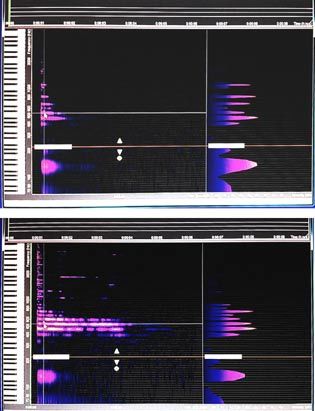The science of Jawari 2
Wim van der Meer and I made a series of exploratory sonograms and spectrograms to give a visual aid to help us understand these somewhat complex processes.This can also be seen by using a simple overtone analyzer (see upper photo), representing a recording from a tanpura with a medium quality jawari. The lower photo is the same bridge with the addition of the jiva. A very clear difference can be seen, and indeed proves Ramans observations that the jiva enhances the spectrum of overtones. This can be clearly heard with the naked ear.

As seen when comparing the two photos, inharmonics—frequencies that bear no relation to the basic tonic or fundamental—are also produced. C.V. Raman attributes this to the string vibrating over a curved bridge, creating an indefinite and shifting point of contact. However, B.C. Deva argues that this phenomenon is not solely due to the lengthening and shortening of the string but also because the jiva lifts the string from the bridge. In that instant, the vibration is momentarily damped, giving the tanpura its distinctive resonance among India's flat-bridge lutes.
The way overtones emerge from a jawari bridge is much like a beam of white light passing through a prism. Just as the prism reveals the hidden spectrum of colours, the jiva allows the full range of overtones to unfold from a single note. The result is a complex, resonant sound, where the overtones blend like the soft hues of a rainbow. After all, both light and sound are waves, their frequencies governed by the same physical principles—one reaching the eye, the other the ear.
In practice, inharmonics remain subtle; they are usually weak or overshadowed by the stronger tones, lingering at the edges of perception.
